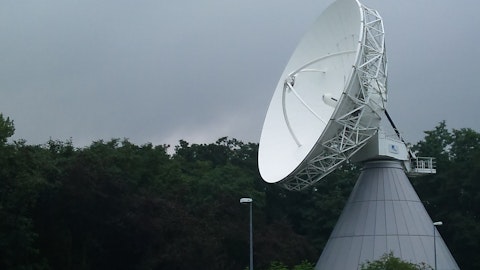But we kind of did that knowingly. We know there was competition, and there just wasn’t much potential beyond the particular program. And we could have taken those, we could’ve gotten those programs, we know what would have taken, but we will lost money. And it just doesn’t make any sense to do that. So I don’t know if that’s a helpful.
Unidentified Analyst: Yes, that’s — it sounds as if you’re going about the process in a very reasonable fashion. I have another question about your income taxes. They were tiny in the recent quarters as compared with the historic tax rate. Do you — is that because of loss carryforwards? And when do you expect to get back to what I believe was more like a rate in the mid-20s or around there. When do you think you’ll go back to that kind of tax rate?
Steve Bernstein: We do — it is because of NOLs. The tax we’re paying now was mandatory state taxes and things of that nature. I can’t predict exactly when the NOLs will run out. But I can tell you, as you see the performance in the last couple of years, we have a bunch of NOLs going forward that we will be using for a while.
Unidentified Analyst: Okay. Okay. All right. That’s it for me. Thanks very much for the good work you’re doing.
Thomas McClelland: Okay. Thanks.
Operator: Thank you. We have a question coming from Jeffrey Cohen from Mulholland Capital Management. Jeffrey, your line is live.
Jeffrey Cohen: Yeah, good afternoon. How are you all? I appreciate all the color as other callers have reflected. Just real quick, you talked about the target gross margin above 50%. What sort of quarterly revenue run rate would that contemplate?
Thomas McClelland: Steve, do you want to…
Steve Bernstein: We don’t — we’re not fully ready to guide how revenue will grow long term. We believe it will grow. And from there, we’ll see the efficiency we get from the growth and the margin.
Jeffrey Cohen: Yes. No, I appreciate that. But I mean, if 50% gross margin is your target, you must have some sort of underlying assumption in terms of what sort of revenues you need to get there? So that’s my question.
Thomas McClelland: Well, I — I’ll put things differently because I don’t think it’s — that target is not really based on a particular revenue goal. I think that target is based — it’s really a question of how we’re bidding new business. And that’s the target for new business is a gross margin of 50%. And I just talked about the particular contract that we lost. And that’s because when we bid it at 50%, we didn’t get it. And that made sense in that particular case. Now there are going to be some cases where we’re going to bid at lower gross margin because there is good reason to do that. But in general, we’re really targeting 50%, and that’s kind of a baseline approach to things. And it’s really not that — is not based on a particular revenue assumptions.
Jeffrey Cohen: Okay. But just so I’m clear, you’re not talking about your six- to 12-month goal being you’re necessarily getting 50% gross margin on your contracts. You’re talking about being able to show that in a quarterly report, correct?
Thomas McClelland: I’m not quite sure I understand the distinction there.
Jeffrey Cohen: Well, I think there’s a distinction between bidding a project at a 50% gross margin and actually bringing that down to your financial results.
Thomas McClelland: Okay. That’s certainly true.
Jeffrey Cohen: And so when you put out that target, you’re talking about the latter, correct? I mean…
Thomas McClelland: Yes.
Jeffrey Cohen: Yes. Okay. Can you quantify your bidding activity at all? The amount of outstanding bids or the sales funnel or in some way quantify that?
Thomas McClelland: I don’t think I’m prepared to do that in a very meaningful fashion. Qualitatively, very qualitatively, I think the pipeline is pretty full at this point in time. We have a tremendous amount of bidding activity going on. But I — yes, I’m not really in a position to put a total dollar amount on things at this time.
Jeffrey Cohen: Okay. And Steve, I was just curious, you said you have a lot of NOLs. Can you — what would they be on a cumulative basis roughly?
Steve Bernstein: I don’t have the exact number, but I’ll say it’s approximately $20 million, give or take.
Jeffrey Cohen: Okay. All right, that’s all I had. Thanks so much.
Thomas McClelland: Okay. All right, thank you.
Operator: And that’s all of the questions that we had. I would now like to hand the call back to Tom McClelland for his closing remarks.
Thomas McClelland: Okay. Thank you. I think we’ve been on the call for quite a while at this point in time. I appreciate everybody’s participation. And I’d like to wish everybody happy and healthy holidays and that’s it. Thank you very much.
Operator: Thank you. This does conclude today’s conference. You may disconnect your lines at this time, and have a wonderful day. Thank you for your participation.
Follow Frequency Electronics Inc (NASDAQ:FEIM)
Follow Frequency Electronics Inc (NASDAQ:FEIM)
Receive real-time insider trading and news alerts



